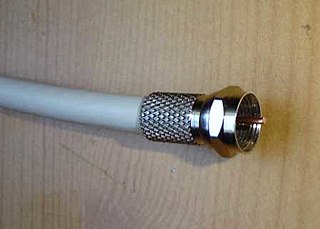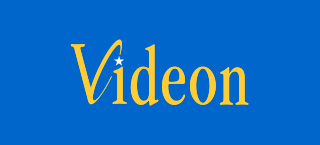
Cable television is a system of delivering television programming to consumers via radio frequency (RF) signals transmitted through coaxial cables, or in more recent systems, light pulses through fibre-optic cables. This contrasts with broadcast television, in which the television signal is transmitted over-the-air by radio waves and received by a television antenna attached to the television; or satellite television, in which the television signal is transmitted over-the-air by radio waves from a communications satellite orbiting the Earth, and received by a satellite dish antenna on the roof. FM radio programming, high-speed Internet, telephone services, and similar non-television services may also be provided through these cables. Analog television was standard in the 20th century, but since the 2000s, cable systems have been upgraded to digital cable operation.
NAPLPS is a graphics language for use originally with videotex and teletext services. NAPLPS was developed from the Telidon system developed in Canada, with a small number of additions from AT&T Corporation. The basics of NAPLPS were later used as the basis for several other microcomputer-based graphics systems.

Telidon was a videotex/teletext service developed by the Canadian Communications Research Centre (CRC) during the late 1970s and supported by commercial enterprises led by Infomart in the early 1980s. Most work on the system ended after 1985, having failed to build critical mass.

Videotex was one of the earliest implementations of an end-user information system. From the late 1970s to early 2010s, it was used to deliver information to a user in computer-like format, typically to be displayed on a television or a dumb terminal.

A cable television headend is a master facility for receiving television signals for processing and distribution over a cable television system. A headend facility may be staffed or unstaffed and is typically surrounded by some type of security fencing. The building is typically sturdy and purpose-built to provide security, cooling, and easy access for the electronic equipment used to receive and re-transmit video over the local cable infrastructure. One can also find head ends in power-line communication (PLC) substations and Internet communications networks.

CKND-DT is a television station in Winnipeg, Manitoba, Canada, part of the Global Television Network. The station is owned and operated by network parent Corus Entertainment, with studios on the 30th floor of 201 Portage in downtown Winnipeg, and transmitter atop the building.

CHMI-DT is a television station licensed to Portage la Prairie, Manitoba, Canada, broadcasting the Citytv network to the Winnipeg area. Owned and operated by Rogers Sports & Media, the station has studios at 8 Forks Market Road in downtown Winnipeg, and its transmitter is located adjacent to Bohn Road in Cartier.
CTV 2 Atlantic is a Canadian cable television channel serving Atlantic Canada owned by Bell Media, with its studios located in Halifax, Nova Scotia. Owned by the Bell Media subsidiary of BCE Inc., it operates as a de facto owned-and-operated station of its secondary CTV 2 television system.

Super Écran is a Canadian premium television network owned by Bell Media. It airs a mix of commercial-free films and television series. Films are primarily sourced from the United States and Canada, while the television series mostly consist of original series and programs from HBO and Showtime in the United States.

SMATV is Single Master Antenna Television , The purpose of SMATV is for supplying and controlling the number and type of channels to multiple televisions. Not only TV channels but FM channels as well. It provides Reception of DBS TV/FM channels for hotels, motels, dormitories, schools, hospitals and commercial properties with multiple tenants. Using a master antenna system video signals, audio signals and decoder signals can also be distributed.

Prairie Public Television is a state network of public television stations operated primarily by Prairie Public Broadcasting. It comprises all of the PBS member stations in the U.S. state of North Dakota.

Shaw Broadcast Services is the division of Canadian telecommunications company Shaw Communications that is responsible for providing and managing the distribution of television channels to cable companies via satellite. Shaw Communications also operates Shaw Direct, a Canadian direct broadcast satellite service.
WeatherStar is the technology used by American cable and satellite television network The Weather Channel (TWC) to generate its local forecast segments—branded as Local on the 8s (LOT8s) since 2002 and previously from 1996 to 1998—on cable and IPTV systems nationwide. The hardware takes the form of a computerized unit installed at a cable system's headend. It receives, generates, and inserts local forecasts and other weather information, including weather advisories and warnings, into TWC's national programming.

C Channel was a short-lived Canadian premium television channel specialising in arts programming. It was one of Canada's first licensed "pay TV" channels when it began in 1983 but it ended in failure within five months.
The Life Channel was a Canadian premium television service featuring programming on lifestyle and health subjects, existing for almost 14 months in the late 1980s. The programming represented some of the earlier efforts of Canada's premium television industry, considering pay-TV movie channels had commenced in 1983. It should not be confused with later Canadian cable channels Life Network and CTV Life Channel.
CBC Parliamentary Television Network was a Canadian cable television specialty channel that broadcast the House of Commons of Canada proceedings via Anik satellite to Canadian cable television headends between September 1979 and 1992.

Videon Cablesystems was a Canadian cable television service in Manitoba, Alberta, and for a short period, northwest Ontario. The company was owned by Moffat Communications Ltd. and Randall L. Moffat was its president.
Addressability is the ability of a digital device to individually respond to a message sent to many similar devices. Examples include pagers, mobile phones and set-top boxes for pay TV. Computer networks are also addressable via the MAC address on Ethernet network cards, and similar networking protocols like Bluetooth. This allows data to be sent in cases where it is impractical to control exactly where or to which devices the message is physically sent.
Hotel television systems are the in-suite television content presented in hotel-rooms, other hotel environments and in the hospitality industry for in-room entertainment, as well as hospitals, assisted living, senior care and nursing homes. These services may be free for the guest or paid, depending on the service and the individual hotel's or hotel chain’s policy. Generally these services are controlled by using the remote control.
The American cable and satellite television network Pop was originally launched in 1981 as a barker channel service providing a display of localized channel and program listings for cable television providers. Later on, the service, branded Prevue Channel or Prevue Guide and later as Prevue, began to broadcast interstitial segments alongside the on-screen guide, which included entertainment news and promotions for upcoming programs. After Prevue's parent company, United Video Satellite Group, acquired the entertainment magazine TV Guide in 1998, the service was relaunched as TV Guide Channel, which now featured full-length programs dealing with the entertainment industry, including news magazines and reality shows, along with red carpet coverage from major award shows.












